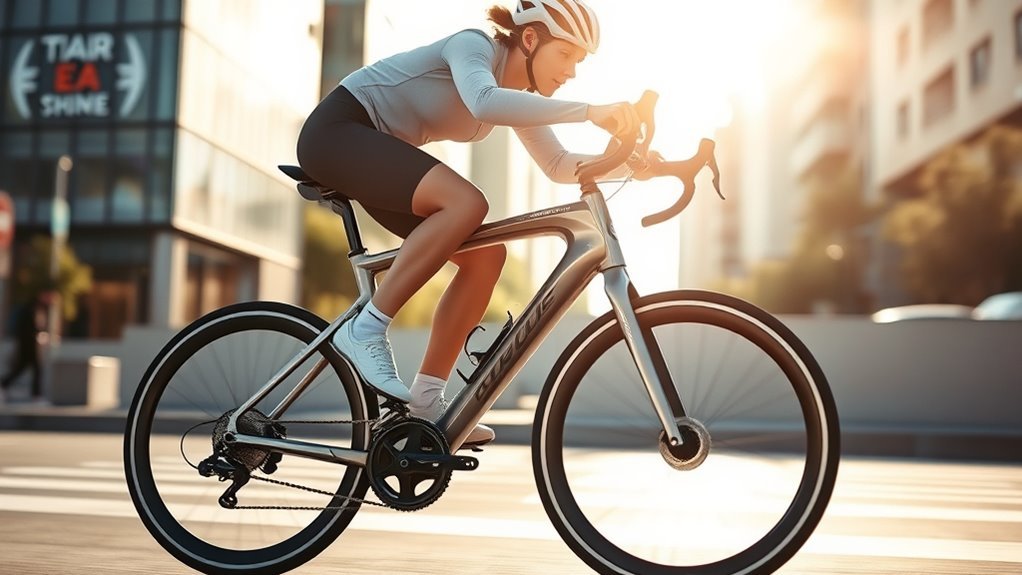Ventilation vs. Aerodynamics: Balancing Comfort and Speed
Balancing ventilation and aerodynamics is essential for optimizing comfort and speed in vehicle design. Streamlined shapes reduce drag, while effective ventilation systems manage cabin temperature and airflow. Proper integration of these elements enhances performance and passenger experience. Keep in mind that the ideal balance affects not just fuel efficiency but also user comfort. Exploring innovations in this field reveals how future vehicles can achieve this harmony, offering both enhanced speed and a superior driving environment.
Understanding Aerodynamics: The Science Behind Speed

While you may think of aerodynamics mainly in the context of high-speed vehicles or aircraft, it actually encompasses the study of how air interacts with solid objects, influencing speed and efficiency. Understanding aerodynamic principles is essential for optimizing performance. By analyzing airflow dynamics, you can identify how shapes, surfaces, and angles affect drag and lift. For instance, a streamlined design reduces resistance, allowing for smoother movement through the air. Equally important is the management of air pressure around the object; maintaining a balance can enhance stability and control. Consequently, grasping these concepts not only empowers you to enhance vehicle design but also liberates your creative potential in engineering, ensuring a harmonious blend of speed and freedom.
The Importance of Ventilation in Vehicle Design

Although aerodynamics is essential for maximizing speed, effective ventilation is equally important in vehicle design, as it directly impacts performance, safety, and comfort. Active airflow systems enhance thermal comfort by regulating cabin temperatures, guaranteeing a pleasant environment for occupants. These systems help dissipate heat generated by the engine and maintain ideal air quality, critical for long drives. Without proper ventilation, excessive heat can compromise performance, leading to potential mechanical failures. Additionally, efficient airflow contributes to the overall driving experience, allowing you to focus on the road without distractions. Balancing ventilation and aerodynamics is significant; achieving this harmony assures that you enjoy both speed and comfort, enhancing your sense of freedom behind the wheel.
How Aerodynamics Affects Fuel Efficiency

Aerodynamics plays a critical role in determining your vehicle’s fuel efficiency through streamlined design and reduced drag coefficient. By enhancing the shape of your vehicle, you can greatly lower air resistance, which directly affects fuel consumption. Additionally, understanding the ideal speed range for your vehicle can help you maximize efficiency and minimize energy loss.
Streamlined Vehicle Design
Streamlined vehicle design plays an essential role in enhancing fuel efficiency by minimizing air resistance during motion. By incorporating aerodynamic shapes and effective airflow management, you can considerably reduce the energy required to propel your vehicle. This design philosophy not only optimizes speed but also contributes to lower fuel consumption.
- Smooth curves reduce turbulence.
- Sleek profiles enhance airflow.
- Strategic vent placements improve efficiency.
When your vehicle’s design is optimized for aerodynamics, you’re not just enjoying the thrill of speed; you’re also embracing a more sustainable driving experience. Each decision in the design process directly impacts how effortlessly your vehicle slices through the air, ultimately granting you the freedom to travel further with less fuel.
Impact on Drag Coefficient
When designing a vehicle, understanding the impact of drag coefficient on fuel efficiency is essential, as even minor adjustments can lead to significant improvements in performance. By focusing on drag reduction and effective airflow management, you can enhance both speed and economy. Here’s a quick overview of how drag affects fuel consumption:
| Drag Coefficient | Fuel Efficiency Impact |
|---|---|
| 0.25 | Ideal; minimal drag |
| 0.30 | Moderate; slight increase in fuel use |
| 0.35 | Noticeable; higher resistance, decreased efficiency |
| 0.40 | Poor; significant fuel consumption increase |
Optimal Speed Range
Understanding the ideal speed range for a vehicle can greatly enhance fuel efficiency, as aerodynamic factors play a pivotal role in how air interacts with the vehicle body. Speed optimization isn’t just about going fast; it’s about finding that sweet spot where comfort metrics align with performance.
Consider these factors:
- Drag Reduction: At specific speeds, the vehicle’s shape minimizes resistance.
- Engine Efficiency: Best RPMs can lead to better fuel consumption.
- Comfort Level: Reduced vibrations and noise enhance your driving experience.
Innovative Ventilation Systems in Modern Vehicles
Innovative ventilation systems in modern vehicles are transforming how we experience cabin air quality and temperature control. By employing active airflow techniques, these systems enhance efficiency, allowing you to customize your environment based on personal preferences. Advanced climate control mechanisms now monitor internal conditions, adjusting airflow dynamically to maintain ideal comfort levels. This technology not only improves your driving experience but also promotes energy efficiency, balancing the need for comfort with the demands of performance. Additionally, many vehicles now integrate smart sensors that respond to external weather conditions, further enhancing air circulation. With these innovations, you can enjoy a more pleasant ride without compromising on speed or aerodynamics, achieving a newfound sense of freedom on the road.
The Role of Temperature Regulation in Performance
When evaluating performance, ideal temperature regulation is essential for maintaining efficiency. Elevated humidity levels can further complicate this dynamic, affecting both comfort and operational effectiveness. Understanding these factors allows you to enhance performance through better design and operational strategies.
Optimal Temperature for Performance
Maintaining an ideal temperature is critical for maximizing performance across various activities, from athletic endeavors to industrial processes. The interplay between thermal comfort and performance metrics can greatly influence outcomes. Here are some key aspects to reflect on:
- Thermal Regulation: Your body’s ability to manage heat directly impacts endurance and efficiency.
- Cognitive Function: An optimal temperature promotes focus and decision-making, essential for peak performance.
- Safety and Injury Prevention: Proper temperature control reduces the risk of heat-related issues, ensuring you can push your limits safely.
Impact of Humidity Levels
Humidity levels play an essential role in temperature regulation and, consequently, in performance outcomes across various activities. High humidity can hinder your body’s ability to cool itself through sweat evaporation, leading to fatigue and reduced efficiency. Understanding humidity effects is vital for effective moisture management, especially in sports and high-intensity tasks.
| Humidity Level | Performance Impact | Moisture Management Strategies |
|---|---|---|
| Low (<30%) | Ideal performance | Hydration focus |
| Moderate (30-60%) | Balanced output | Layered clothing |
| High (>60%) | Decreased efficiency | Frequent breaks |
| Very High (>80%) | Risk of heat stress | Cooling systems |
| Variable | Adaptation needed | Adjust activity intensity |
Case Studies: Balancing Ventilation and Aerodynamics
Although achieving an ideal balance between ventilation and aerodynamics can be challenging, case studies provide valuable insights into how various designs and strategies can effectively address this issue. These real-world examples reveal design challenges and innovative solutions, showcasing the importance of tailoring approaches to specific contexts.
- Aerodynamic shapes that minimize drag while allowing for optimal air circulation.
- Active ventilation systems that adapt to speed and environmental conditions to enhance comfort.
- Material choices that promote airflow without compromising structural integrity.
Future Trends in Vehicle Design: A Harmonious Approach
The increasing complexity of vehicle design necessitates a harmonious integration of ventilation and aerodynamics, as demonstrated by recent case studies. You’ll find that future trends focus on sustainable materials, which not only enhance eco-friendliness but also contribute to better airflow management. Flexible designs are becoming vital, allowing manufacturers to adapt shapes that optimize aerodynamic efficiency while maintaining adequate ventilation. Innovations, like adjustable vents and dynamic body contours, promote an environment that prioritizes both comfort and performance. As you explore these advancements, consider how they reflect a broader movement towards vehicles that balance speed with user experience, ensuring freedom in design without compromising on essential functionalities. This approach will redefine your expectations for modern vehicles in the years to come.
Practical Tips for Enhancing Comfort and Speed
When optimizing vehicle performance, balancing comfort and speed is essential, as both factors greatly influence the driving experience. Here are some practical tips to enhance your journey:
- Adjust seating comfort: Confirm your seat provides adequate lumbar support to maintain proper posture during long drives.
- Optimize airflow direction: Position vents to direct airflow precisely, avoiding direct blasts that could disrupt comfort.
- Choose the right tires: Select tires designed for a balance of grip and rolling resistance, enhancing both speed and ride quality.
Frequently Asked Questions
How Can I Improve My Vehicle’s Aerodynamics at Home?
You can improve your vehicle’s aerodynamics at home with some clever DIY upgrades. Sure, you could just let the wind do its thing, but why not take control? Start by ensuring smooth airflow; adding a front air dam or side skirts can do wonders. Don’t forget to seal gaps that disrupt air flow. With a little effort, you can transform your ride into a sleek machine, embracing freedom while reducing drag.
What Materials Enhance Both Ventilation and Aerodynamics?
To enhance both ventilation and aerodynamics, you should consider using mesh fabrics and air permeable materials. These allow airflow while reducing drag. Lightweight composites can also play an essential role, as they maintain structural integrity without adding excess weight. Incorporating aerodynamic shapes in your design maximizes efficiency, channeling airflow effectively. By strategically combining these elements, you’ll create a vehicle that balances comfort and speed, giving you the freedom to enjoy every drive.
Does Aerodynamics Affect Tire Performance?
Absolutely, aerodynamics greatly affects tire performance. When you optimize tire design, you enhance airflow around the tires, reducing drag and improving stability. Maintaining proper tire pressure is essential too; it influences the contact patch with the road, affecting grip and handling. By balancing these factors, you can release your vehicle’s true potential, transforming a mundane drive into a thrilling experience that feels like flying down the highway at lightning speed.
How Does Weather Impact Vehicle Aerodynamics?
Weather greatly impacts vehicle aerodynamics by altering wind resistance and introducing temperature variations. High winds can increase drag, making it harder for your vehicle to maintain speed and efficiency. Conversely, warmer temperatures can reduce air density, potentially lowering wind resistance. You’ll notice that on windy days, your vehicle might require more power to overcome the increased drag. Understanding these factors can help you adapt your driving strategy for ideal performance in varying weather conditions.
Can Aerodynamics Influence Vehicle Noise Levels?
Yes, aerodynamics can greatly influence vehicle noise levels. A well-designed vehicle can enhance airflow dynamics, leading to noise reduction by minimizing turbulence and drag. When airflow is smooth around the vehicle, it reduces wind noise, creating a quieter ride. Conversely, poor aerodynamic design can increase noise levels due to turbulent air. By optimizing shapes and contours, you can effectively decrease unwanted sound, enhancing both comfort and the driving experience.






